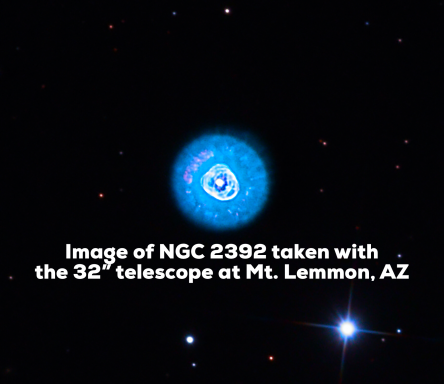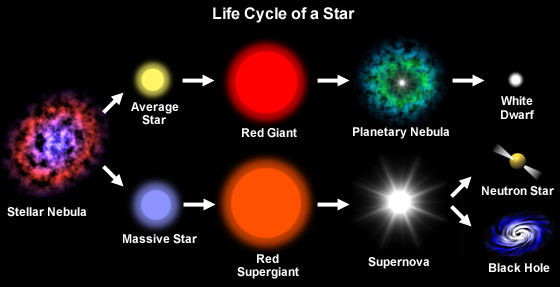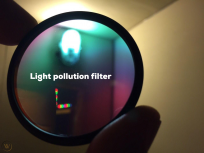 For those of you who are familiar with the blog, you know that I typically focus on celestial objects and events that are accessible to the unaided eye or with binoculars and small telescopes, but this month I’m going to share with you an object that is perhaps best seen in mid-sized (4.5”) scopes or larger. But first, let’s deal with a bit of awkward nomenclature. The name “Eskimo Nebula” has been around for some years but in more enlightened times, “Eskimo” is no longer viewed as a proper name when referring to a group of culturally indigenous people who inhabit the Arctic regions of Canada, Greenland, and Alaska. I don’t like the term either so I will not be using it from this point forward, nor do I like the term “politically correct”, I prefer to call it “being respectful”. Of course, the nebula does have other names. There are the cumbersome catalog designations of NGC 2392 and Caldwell 39 and there is also the moniker of “Clown Face Nebula”. Nope. Don’t like clowns either (childhood trauma, don’t ask).
For those of you who are familiar with the blog, you know that I typically focus on celestial objects and events that are accessible to the unaided eye or with binoculars and small telescopes, but this month I’m going to share with you an object that is perhaps best seen in mid-sized (4.5”) scopes or larger. But first, let’s deal with a bit of awkward nomenclature. The name “Eskimo Nebula” has been around for some years but in more enlightened times, “Eskimo” is no longer viewed as a proper name when referring to a group of culturally indigenous people who inhabit the Arctic regions of Canada, Greenland, and Alaska. I don’t like the term either so I will not be using it from this point forward, nor do I like the term “politically correct”, I prefer to call it “being respectful”. Of course, the nebula does have other names. There are the cumbersome catalog designations of NGC 2392 and Caldwell 39 and there is also the moniker of “Clown Face Nebula”. Nope. Don’t like clowns either (childhood trauma, don’t ask).
 A more suitable name, in my opinion, is the sometimes used “Lion Nebula”. I often refer to it as “The Lion King Nebula”, as images taken by the Hubble Space Telescope, and many ground-based telescopes, reminds me of the poster used to promote the Broadway musical version of the Walt Disney film. Since this is my blog and I have a certain amount of editorial freedom, I’m calling it the Lion Nebula.
A more suitable name, in my opinion, is the sometimes used “Lion Nebula”. I often refer to it as “The Lion King Nebula”, as images taken by the Hubble Space Telescope, and many ground-based telescopes, reminds me of the poster used to promote the Broadway musical version of the Walt Disney film. Since this is my blog and I have a certain amount of editorial freedom, I’m calling it the Lion Nebula.
HOW TO FIND IT

To find the Lion Nebula, we must first locate the constellation of Gemini. On February evenings, look SE right after sunset to find the constellation of Orion. Orion the hunter, will be our guide to the two stars that mark the heads of the Gemini twins, Castor and Pollux.
Orion is very easy to spot with the three stars in a diagonal row that mark where his belt is. If you don’t know where Orion is, use a star chart or a stargazing app to help you out. Now, find the bright, blue-white star Rigel, marking Orion’s left foot, and then find orange-red Betelgeuse, marking the hunter’s right shoulder. Draw an imaginary line from Rigel to Betelgeuse and then extend it further out until you come to two bright stars that are paired close together upon the sky. These two stars represent the stick figure heads of the twins: Pollux and Castor. Pollux is the leftmost star and the brightest of the two; Castor, slightly dimmer, is the one that it more or less to the right.
 Even under moderately light polluted skies, you can see that Pollux and Castor each have fainter stars that outline the stick figure shapes of the twins. Using the stick figure outline, find the fairly bright star that denotes Pollux’s waist. This star is called Wasat. The Lion Nebula is just east of Wasat. Alternatively, you can extend an imaginary line through the belt lines of the twins, heading east. Draw an imaginary line downwards from Pollux’s right arm (his right, not yours). Where it intersects with the line you’ve drawn through the belt lines is the general area to search for the Lion Nebula.
Even under moderately light polluted skies, you can see that Pollux and Castor each have fainter stars that outline the stick figure shapes of the twins. Using the stick figure outline, find the fairly bright star that denotes Pollux’s waist. This star is called Wasat. The Lion Nebula is just east of Wasat. Alternatively, you can extend an imaginary line through the belt lines of the twins, heading east. Draw an imaginary line downwards from Pollux’s right arm (his right, not yours). Where it intersects with the line you’ve drawn through the belt lines is the general area to search for the Lion Nebula.
WHAT YOU ARE SEEING AND HOW TO SEE IT AT ITS BEST
 The Lion Nebula is an example of what’s known as a “planetary nebula”, but they actually don’t have anything to do with planets. The name comes to us from William Herschel, famed English German astronomer who discovered the planet Uranus. In September of 1782, a year after he had discovered the 7th planet, Herschel was at his telescope looking for double stars, an area he specialized in, when he came across a rather curious object. It was small and faint, like some other nebulae he had observed, and it also resolved itself into a disc, like a planet. Flummoxed as to what the thing was, he decided to call it a “planetary nebula” and we’ve been stuck with the name ever since. In fact, it was Herschel who discovered the Lion Nebula in 1787.
The Lion Nebula is an example of what’s known as a “planetary nebula”, but they actually don’t have anything to do with planets. The name comes to us from William Herschel, famed English German astronomer who discovered the planet Uranus. In September of 1782, a year after he had discovered the 7th planet, Herschel was at his telescope looking for double stars, an area he specialized in, when he came across a rather curious object. It was small and faint, like some other nebulae he had observed, and it also resolved itself into a disc, like a planet. Flummoxed as to what the thing was, he decided to call it a “planetary nebula” and we’ve been stuck with the name ever since. In fact, it was Herschel who discovered the Lion Nebula in 1787.
 Today, we know that planetary nebulae (“nebulae” being the plural form of “nebula”) are the last, dying gasps of stars that were once like our own Sun. Stars are born out of the gravitational collapse of massive clouds of gas and dust. It’s gravity that creates the extreme conditions at the centers of protostars needed to kickstart the process of nuclear fusion, thus bringing the star to life. For most of the star’s existence, gravity is constantly trying to crush it down into something smaller. Ironically, it’s the radiation pressure created from all of the nuclear fusion reactions taking place in the core that keeps gravity at bay. Stars can maintain this delicate balance between gravity and the outward pressure from their cores for millions, billions, or even trillions of years, depending upon the mass of the star. But eventually, no matter how massive the star is, the fuel tank in the core will become empty. The high mass stars live short lives because their internal thermostats are set high, so they burn through their fuel quickly and then die explosively as supernovae. Low mass stars live longest because they have their thermostats set low and are more frugal with their fuel supply. Mid-sized Yellow Dwarfs will measure out their lives to several billion years before the fuel gauge reads ‘empty’. Deprived of the fuel they need to sustain nuclear fusion, the core of a Yellow Dwarf contracts and heats up, causing the upper layers of the star to bloat outwards and cool down. This bloating phase near the end of such a star’s life is called the “Red Giant Phase”. As the Red Giant Phase ends, the star has cast off much of its outer layers and has exposed the dead cinder of the core, known as a “White Dwarf”. Dead cinder it may be, but it is still quite hot, and its radiation causes the cast-off outer layers of the star to fluoresce. It’s these fluorescing shells of gas that we perceive as a planetary nebula. Because the shells of gas are often puffed off spherically, we usually see them as having a disc-shape in our telescopes.
Today, we know that planetary nebulae (“nebulae” being the plural form of “nebula”) are the last, dying gasps of stars that were once like our own Sun. Stars are born out of the gravitational collapse of massive clouds of gas and dust. It’s gravity that creates the extreme conditions at the centers of protostars needed to kickstart the process of nuclear fusion, thus bringing the star to life. For most of the star’s existence, gravity is constantly trying to crush it down into something smaller. Ironically, it’s the radiation pressure created from all of the nuclear fusion reactions taking place in the core that keeps gravity at bay. Stars can maintain this delicate balance between gravity and the outward pressure from their cores for millions, billions, or even trillions of years, depending upon the mass of the star. But eventually, no matter how massive the star is, the fuel tank in the core will become empty. The high mass stars live short lives because their internal thermostats are set high, so they burn through their fuel quickly and then die explosively as supernovae. Low mass stars live longest because they have their thermostats set low and are more frugal with their fuel supply. Mid-sized Yellow Dwarfs will measure out their lives to several billion years before the fuel gauge reads ‘empty’. Deprived of the fuel they need to sustain nuclear fusion, the core of a Yellow Dwarf contracts and heats up, causing the upper layers of the star to bloat outwards and cool down. This bloating phase near the end of such a star’s life is called the “Red Giant Phase”. As the Red Giant Phase ends, the star has cast off much of its outer layers and has exposed the dead cinder of the core, known as a “White Dwarf”. Dead cinder it may be, but it is still quite hot, and its radiation causes the cast-off outer layers of the star to fluoresce. It’s these fluorescing shells of gas that we perceive as a planetary nebula. Because the shells of gas are often puffed off spherically, we usually see them as having a disc-shape in our telescopes.
 The Lion Nebula is located some 2,870 light years away and has a radius of approximately 0.34 light years. By knowing the radius and the expansion rate of those shed off outer layers (the expansion velocity for most planetary nebulas is about 70,000 mph), we estimate an upper age limit of around 10,000 years for the nebula, but some estimates place it at an even younger 2,000 years of age. That’s relatively young for a planetary nebula but they don’t last forever. Within a few tens of thousands of years, the shed layers from the dead star will have traveled far enough away from the white dwarf, that its energy will no longer be able to ionize the gas molecules and it will simply fade away.
The Lion Nebula is located some 2,870 light years away and has a radius of approximately 0.34 light years. By knowing the radius and the expansion rate of those shed off outer layers (the expansion velocity for most planetary nebulas is about 70,000 mph), we estimate an upper age limit of around 10,000 years for the nebula, but some estimates place it at an even younger 2,000 years of age. That’s relatively young for a planetary nebula but they don’t last forever. Within a few tens of thousands of years, the shed layers from the dead star will have traveled far enough away from the white dwarf, that its energy will no longer be able to ionize the gas molecules and it will simply fade away.
In small telescopes (2” or 3” of aperture), the nebula appears as a very small, and faintly blue disc. With 5” or 6” of aperture, you can begin to see a well-defined inner shell and a fainter outer shell. With high magnifications (and this nebula handles such things well provided your optics and seeing conditions are up for the task) you may see a distinctly brighter region in the northern part of the inner shell as well as one to the south. Look for textures within the northern section. Large aperture scopes will reveal the tell-tale glow of the white dwarf at the center and some observers, using 12” of aperture, report seeing dark spots resembling eyes staring back at you.
 In 2000, the Hubble Space Telescope imaged the Lion Nebula (as of August 2020, NASA no longer uses the name Eskimo Nebula and now just refers to it as NGC 2392) and it shows an incredible amount of detail, some of which astronomers are still trying to understand. The mane of the lion shows a ring of “comet-like” objects radiating outwards from the centrally located White Dwarf. At this level of resolution, the lion’s “face” looks more like a tangled ball of string. We think this a bubble of material being ejected at high speed by the White Dwarf’s intense stellar wind. These puffed off shells of gas are also chemically enriched by the nuclear fusion processes taking place while the star was alive. From the humble beginnings of fusing hydrogen into helium, the star went on to make elements such as oxygen, nitrogen, and carbon. The cast away shells will eventually dissipate out into space, becoming a part of the interstellar medium; perhaps one day contributing to the future production of new stars.
In 2000, the Hubble Space Telescope imaged the Lion Nebula (as of August 2020, NASA no longer uses the name Eskimo Nebula and now just refers to it as NGC 2392) and it shows an incredible amount of detail, some of which astronomers are still trying to understand. The mane of the lion shows a ring of “comet-like” objects radiating outwards from the centrally located White Dwarf. At this level of resolution, the lion’s “face” looks more like a tangled ball of string. We think this a bubble of material being ejected at high speed by the White Dwarf’s intense stellar wind. These puffed off shells of gas are also chemically enriched by the nuclear fusion processes taking place while the star was alive. From the humble beginnings of fusing hydrogen into helium, the star went on to make elements such as oxygen, nitrogen, and carbon. The cast away shells will eventually dissipate out into space, becoming a part of the interstellar medium; perhaps one day contributing to the future production of new stars.
Whenever I look at planetary nebulae I am enchanted by their ephemeral beauty, fascinated by what they can tell us about the life and death of stars, and specifically by what they can tell us about the eventual fate of our own Sun. It’s all a part of the awe and wonder to be found in the night sky.